The NVIDIA GeForce GTX 1070 Ti Founders Edition Review: GP104 Comes in Threes
by Nate Oh on November 2, 2017 9:00 AM EST- Posted in
- GPUs
- GeForce
- NVIDIA
- Pascal
- GTX 1070 Ti
Power, Temperature, & Noise
As always, we'll take a look at inter-related metrics of power, temperature and noise. Particularly with noise, these factors can render unwanted even a decently-performing card, a situation that usually goes hand-in-hand with high power consumption and heat output. As this is a new GPU, we will quickly review the GeForce GTX 1070 Ti's stock voltages as well.
| GeForce Video Card Voltages | |||||
| GTX 1070 Ti Boost | GTX 1070 Boost | GTX 1070 Ti Idle | GTX 1070 Idle | ||
| 1.062v | 1.062v | 0.65v | 0.625v | ||
With the exception of a slightly higher idle voltage, everything remains the same in comparison to the GTX 1080 and 1070. The idle voltage actually matches the GTX 1080 Ti idle voltage, but isn't particularly significant as it seems to vary from card to card. In comparison to previous generations, these voltages are exceptionally lower because of the FinFET process used, something we went over in detail in our GTX 1080 and 1070 Founders Edition review. As we said then, the 16nm FinFET process requires said low voltages as opposed to previous planar nodes, so this can be limiting in scenarios where a lot of power and voltage are needed, i.e. high clockspeeds and overclocking.
Fortunately for NVIDIA, GP104 has always been able to clock exceptionally high, at least the good chips, so with a slight knock on efficiency in the form of a 180W TDP, the GTX 1070 Ti Founders Edition is also able to clock exceptionally high, and then a little more. I also suspect the maturity of TSMC's 16nm FinFET process is playing a part here, but the card's higher TDP and NVIDIA's clockspeed choices make it hard to validate that point.
| GeForce Video Card Average Clockspeeds | |||
| Game | GTX 1070 Ti | GTX 1070 | |
| Max Boost Clock |
1898MHz
|
1898MHz
|
|
| Battlefield 1 |
1826MHz
|
1797MHz
|
|
| Ashes: Escalation |
1838MHz
|
1796MHz
|
|
| DOOM |
1856MHz
|
1780MHz
|
|
| Ghost Recon Wildlands |
1840MHz
|
1807MHz
|
|
| Dawn of War III |
1848MHz
|
1807MHz
|
|
| Deus Ex: Mankind Divided |
1860MHz
|
1803MHz
|
|
| Grand Theft Auto V |
1865MHz
|
1839MHz
|
|
| F1 2016 |
1840MHz
|
1825MHz
|
|
| Total War: Warhammer |
1832MHz
|
1785MHz
|
|
The end result is that the GTX 1070 Ti is amusingly able to reverse the GeForce Founders Edition trend of decreased clocks with higher-performing models; that is, as we reviewed them, the GTX 1080 Ti maintained lower clockspeeds than the GTX 1080, which in turn had lower average clockspeeds than the vapor-chamberless GTX 1070, which had lower clockspeeds than the GTX 1060. Typically, that was the case due to extra hardware units, and thus extra power consumption and heat. But as we see in the GTX 1070 Ti Founders Edition, despite the extra SMs and such, the vapor chamber and higher TDP work well in allowing the GTX 1070 Ti to boost high. In fact, higher than the GTX 1070 FE across the board, but in relative terms the clockspeeds only come out to about 2% faster on average than the GTX 1070 FE. In relation to the 1683MHz boost specification, the GTX 1070 Ti on average clocks nearly 10% above that in these games, though that is something we've already seen with previous Pascal cards. And we can also start to see the line of thinking that leads to framing the GTX 1070 Ti as an "overclocking monster."
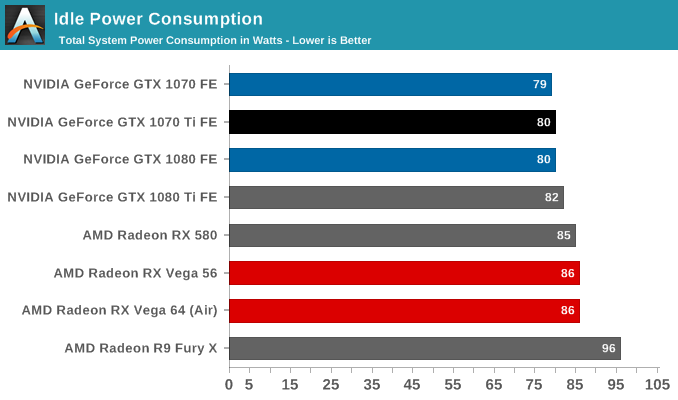


As those higher clockspeeds bear out in power, heat, and noise, there are no surprises here with the GTX 1070 Ti Founders Edition. We've already seen several variations in the aforementioned Founders Edition cards. Here, the blower and vapor chamber are more than adequate for what the card can put out, and in turn lessening the work (and noise) the fan needs to do.
Given the higher 180W TDP, the card can also be closer to GTX 1080 levels of power consumption if need be, though with measurements at the wall, the accuracy of quantification is less than ideal. But in any case, the GTX 1070 Ti has no real necessity to be a power-sipper at this performance range, for which the crown has already gone to the GTX 1070. On top of that, drops in power efficiency will likely not be noticable when compared to its RX Vega competition, or even just against RX Vega 56, whose Battlefield 1 power consumption at the wall is closer to the GTX 1080 Ti FE than the GTX 1080, let alone the GTX 1070 Ti FE.
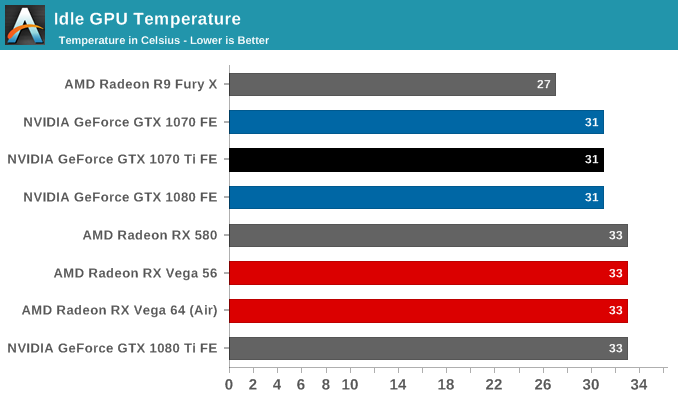
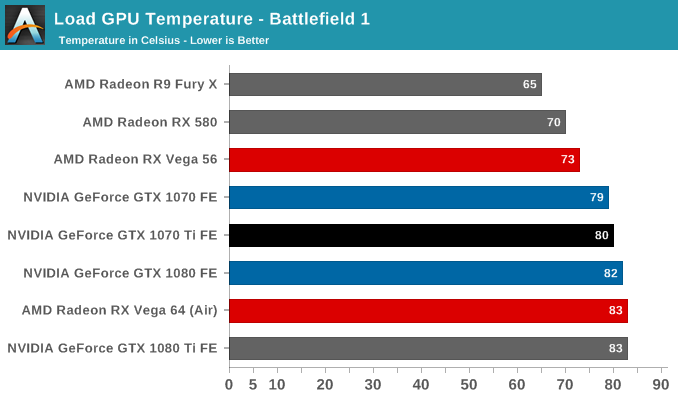
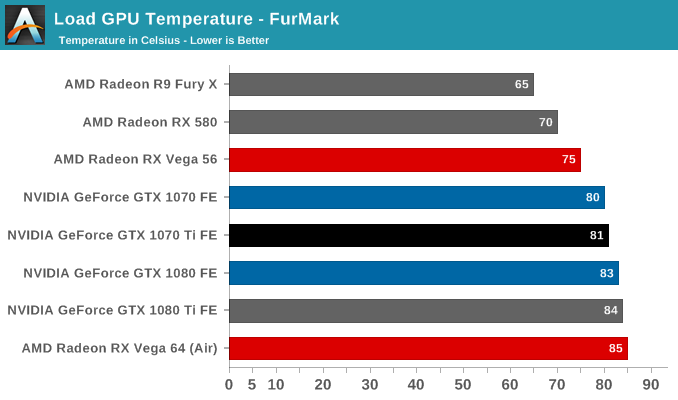
As far as heat and noise go, the GTX 1070 Ti FE has the same 83C throttle point as the GTX 1080 and 1070 FEs, and will approach there under load, though with the GTX 1080's vapor chamber cooler, is kept a little cooler. This follows in fanspeeds and noise as well, and particularly in the eternal power-virus that is Furmark. So for both temperature and noise, the GTX 1070 Ti FE sits right in between the GTX 1080 and 1070 FEs.
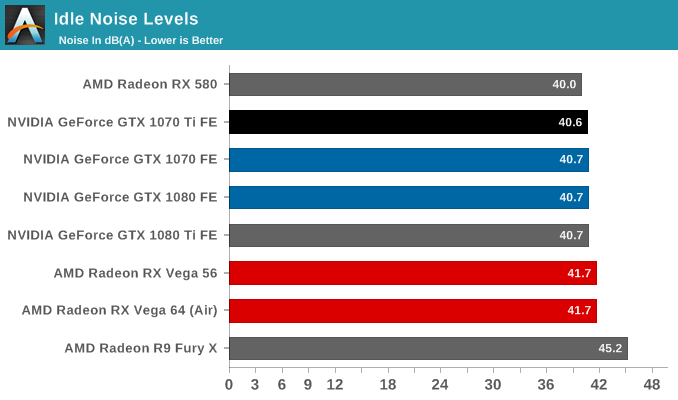
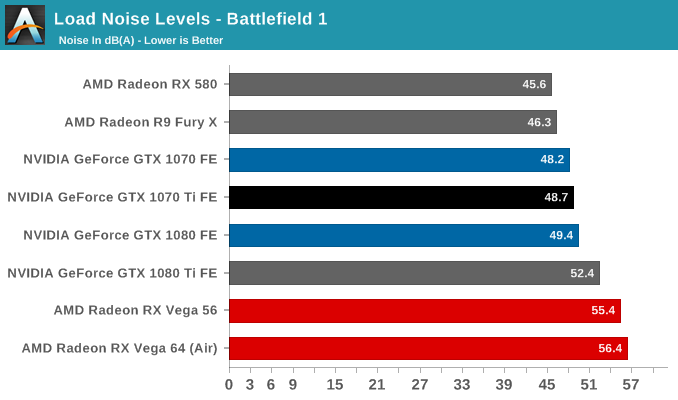
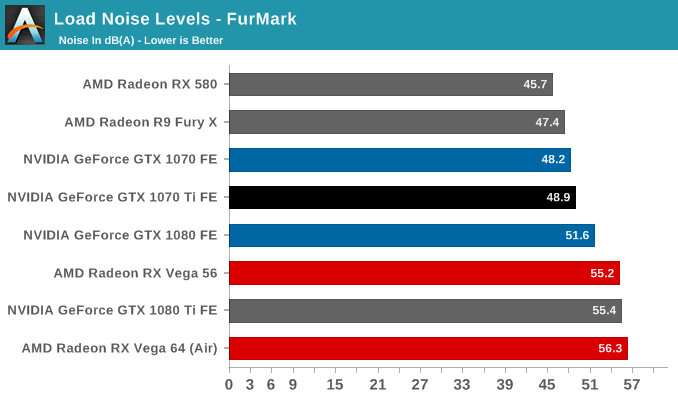










78 Comments
View All Comments
CiccioB - Thursday, November 2, 2017 - link
Price is dictated by the basic market supply/demand rule.Being a so basic rule, I can't understand why people continuously whine about too high prices.
Do you think you are better than the entire nvidia marketing team?
Do you think that lowering the prive as you suggest is going to make nvidia gain more money?
kmmatney - Thursday, November 2, 2017 - link
Why should our goal be to make NVidia more money?nyquaxyla - Thursday, November 2, 2017 - link
Why should Nvidia's goal be to make any less money than the most that they can make?I'm not saying that I like this system.. I too wish there was more competition from AMD, and GPU prices were lower.. but the harsh reality is that profits are the ultimate decider, and every business will try to maximize the same.. it doesn't make them bad or evil people.
darckhart - Thursday, November 2, 2017 - link
Come on, this card shouldn't even exist. Only because miners have created supply shortages has NV decided to put another something out there. It's purely a cash grab. 1 less SM than a 1080? No factory overclocks because it could cannibalize 1080 sales? The only people looking for new 1080s are probably miners once again. And compete against Vega56? Come on. No one can GET a Vega56 at MSRP.CiccioB - Friday, November 3, 2017 - link
You are getting it wrong.People here whine about how the things should work and indeed they work that way.
Companies exists to make money (rule number one companies based on capitals) and whining because they try to make more of them is quite useless like whining about the fact that if you leave your smartphone it will fall down.
So constantly speaking about wrong or right prices from OUR point of view is useless and quite stupid. I can't see people whining about the fact that the gravity is too high and that falling smartphones can't be grabbed before they touch the ground.
They are basic rules that makes things work (one the economics, the other one the universe) so it is really useless to point about wrong prices. People have learnt that whining about gravity won't change the effects, but it appears that they have still not understood that good prices is a simple supply/demand affair.
We all would like a GTX1080/Vega to cost $50 and that smartphones would not fall so fast, but that is our vain wish, not what can be either possible or even clever to discuss on a technical forum like this one. More if you do not understand economics.
kmmatney - Friday, November 3, 2017 - link
These cards are marketed to gamers. However the "demand" (what is driving up the price) is not from gamers, it's from miners. So the high prices are artificial - if miners weren't snapping up all the cards, they would be lower. Heck, the cards can't even get down to MSRP - we can at least complain about that. At least I bought my 1060 at MSRP, and it is still good enough for now.babadivad - Thursday, November 2, 2017 - link
I still think the Vega 56 is the best value card out there. Granted you can find one.Samus - Thursday, November 2, 2017 - link
I was at Microcenter a month ago when the Vega56 was just becoming available at retail, and this guy was talking to the sales clerk about how it's his fifth one for mining and I just wanted to punch him. He'd apparently been coming back to the store repeatedly to buy them all.That's why I can't find any fucking video cards to upgrade my GTX970/980. And considering it still plays everything (albeit at medium detail in some stuff) I'm just going to ride this GPU gravy train out.
tipoo - Thursday, November 2, 2017 - link
Just when they reach a point of convergent evolution with Intel designs, they seem to slip away on GPUs. Maybe AMD just can't sustain three tentpolls (counting APUs) at once? Spin-out?
Nvidia is spending 3 billion on each new architecture (and in that cost, spliting compute architectures from gaming architectures), while AMD I don't think is even hitting the big B on new architectures, and keeping one for both sides. Too bad, but no wonder results are like this.
Anyways, per the 1070TI, I don't suppose the MRSP will be anywhere near realistic for a while as eth miners are still snapping up any good cards.
Manch - Thursday, November 2, 2017 - link
AMD doesn't have a 1080TI fighter, cant compete on efficiency, and the cards came too little too late. It wasn't enough to match year old cards, they needed to beat them. Miners are their only saving grace right now.That being said, there were some design choices made with integration in mind ala RR, and I think it will pay off in the long run but it wont move cards into gamers hands right now.
Asf or the 1070TI, I don't see the point but I get why NVidia is doing it. Adds an option, crowds out the 56, gives them something to do with those other chips.
IF they actually sell at what they're supposed to sell at, I don't see why you wouldn't spring for the 1080. Price/Perf diff isn't worth the savings when spending that much.